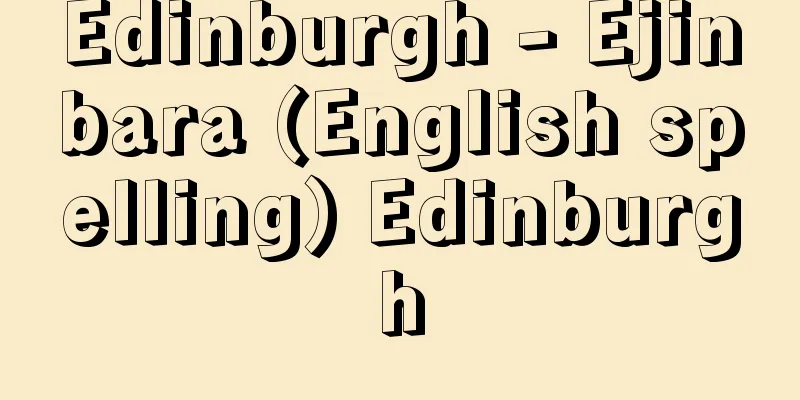Edinburgh - Ejinbara (English spelling) Edinburgh

|
Edinburgh is the capital of Scotland, one of the United Kingdom. It is located in the east of Scotland, on the south shore of the Firth of Forth, which opens into the North Sea. It is the second largest city in the kingdom after Glasgow, located about 70 km west, with a population of 448,624 (2001). It is the administrative, academic and cultural center. The name comes from the Gaelic Duneideann, meaning "Hill of Aiden." At the western end of the old town is a castle mountain called Castle Rock, and Edinburgh Castle towers over the city. This beautiful ancient city is called the "Athens of the North" because it resembles an acropolis. Although it is close to the 56th parallel north, the climate is mild due to the influence of ocean currents and the westerly winds. Tourism is the main industry, but in addition to publishing and printing, papermaking, and whiskey brewing, the outer port of Leith also has shipbuilding, machinery, and food industries. The Old Town, which runs roughly east-west, is centered on the Royal Mile, a street that stretches from Edinburgh Castle at the west end to Holyroodhouse Palace at the east end. It is home to St. Giles Church, the Old Parliament House, the house of the reformer John Knox, and Holyrood Abbey. The Abbey is said to be the epitome of 13th-century British architecture, and Holyroodhouse Palace was built on part of the abbey grounds as the residence of Mary, Queen of Scots. St. Margaret's Chapel, built in 1076, is located within Edinburgh Castle. The New Town spreads out to the north, across the valley on the north side of the Royal Mile. The valley that separates the old and new towns contains Edinburgh (Waverley) Station, the W. Scott Memorial, the Royal Scottish Academy, the National Gallery, and gardens. Most of the New Town is a grid-like street designed by James Clive, and was built between 1768 and 1850. Princes Street is a busy street along the southern edge of the new town, with many shops. Georgian-style buildings remain in the new town. Scottish poet Burns praised this beautiful city, saying, "Edinburgh, O ye city of Scotia, welcome thy palace and thy tower." Every year from late August to early September, the Edinburgh Festival is held, featuring music and theater performances. In 1995, both the old town and the new town were registered as cultural heritage sites of the World Heritage Sites (World Cultural Heritage). [Iwao Yoneda] historyThere are remains of a prehistoric settlement in the vicinity, and during the Roman Empire, it is said that the Roman army built a fort in Cramond, a village on the Firth of Forth. However, the history of Edinburgh really began when a Celtic tribe called Godowdin built a fort on what is now Castle Rock. It then came under Northumbrian control in the first half of the 7th century. Eventually, descendants of MacAlpin, King of Scotland, took control of Edinburgh in the mid-10th century, and Malcolm III's wife Margaret built a chapel on Castle Rock. This is the oldest surviving building in Edinburgh. His son, David I, built Holyrood Abbey in 1128 (rebuilt around 1220). St. Giles' Church was also built around the same time. Edinburgh was often plundered by English kings, especially Edward I, who claimed to be the feudal superior of Scotland, but in 1329, during the War of Independence, Edinburgh was granted a charter by Robert I. The city expanded greatly in the 15th century, and the Stuart kings gradually came to regard Edinburgh as their capital. The Scottish Reformation of 1560 was carried out in Edinburgh, and in 1583, a city university named after James VI (later the University of Edinburgh) was established. When James VI moved to London in 1603, Edinburgh lost its court and its status declined. The riots at St. Giles Church (1637), which began with the imposition of the Prayer Book, were one manifestation of the frustration of the citizens who had lost their court. Edinburgh also played a leading role in the political and religious revolutions of the 1640s. The 18th century saw a new era for Edinburgh. The indifference of William II after the Glorious Revolution, the failure of the Darien Plan to establish a colony on the Isthmus of Panama, and the union with England in 1707 once again irritated the Edinburgh people, but they began to look to the north for a cultural capital. The "Scottish Enlightenment" was mainly a product of Edinburgh. After 1760, the city was expanded, and new areas such as Princes Street were built in the north. It was during this period that poet and novelist W. Scott and judge Lord Cockburn were active. The Industrial Revolution did not bring about any major changes to the city. In the 20th century, residential areas expanded to the suburbs, and the old Edinburgh is rapidly changing. The Edinburgh Festival was started in 1947. [Keiji Iijima] [References] | |The old town is on the south side of the city (left side of the photo), and the new town is on the north side (right side of the photo). Princes Street runs through the center. World Heritage Site "Old and New Towns of Edinburgh" (England, registered in 1995) Edinburgh, England ©Shogakukan "> Edinburgh city An ancient castle on a cliff (Castle Rock). Since the late 11th century, it has been the site of many historical events. Part of the World Heritage Site "Old and New Towns of Edinburgh" (England, registered in 1995) Edinburgh, England ©Masashi Tanaka "> Edinburgh Castle A palace located on the grounds of Holyrood Abbey. Known as the residence of Mary, Queen of Scots. World Heritage Site "Old and New Towns of Edinburgh" (United Kingdom, registered in 1995) Edinburgh, United Kingdom ©Shogakukan "> Palace of Holyroodhouse Source: Shogakukan Encyclopedia Nipponica About Encyclopedia Nipponica Information | Legend |
|
イギリスを構成する連合王国の一つスコットランドの首都。スコットランド東部、北海に向かって開くフォース湾の南岸に位置する。西方約70キロメートルのグラスゴーに次ぐ同王国第二の都市で、人口44万8624(2001)。行政、学術、文化の中心都市。名称は、ゲール語の「エイデンの丘」を意味するダンエイディアンDuneideannに由来する。旧市街の西端にカッスル・ロックとよばれる城山があり、市街地を見下ろすようにエジンバラ城がそびえ立っている。これをアクロポリスに見立てて「北方のアテネ」と称される美しい古都である。北緯56度に近いが、海流や偏西風の影響で、気候は温和である。産業は観光が主であるが、出版・印刷、製紙、ウイスキー醸造などのほか、外港のリースLeithでは造船、機械、食料品などの工業が行われる。 ほぼ東西に走る旧市街は、西端のエジンバラ城から東端のホーリールードハウス宮殿までのロイヤル・マイルとよばれる通りが中心で、セント・ジャイルズ教会、旧議事堂、宗教改革者ジョン・ノックスの家、ホーリールード寺院などがある。同寺院は13世紀のイギリスの粋を集めたといわれる建築で、寺院の敷地の一部に、スコットランド女王メアリーの居城としてホーリールードハウス宮殿が建てられた。エジンバラ城内には1076年建立のセント・マーガレット礼拝堂がある。ロイヤル・マイルの北側にある谷を挟んで、新市街が北方に広がっている。新旧両市街を分ける谷にはエジンバラ(ウェーバリー)駅、W・スコット記念碑、ロイヤル・スコティッシュ・アカデミー、国立美術館、庭園などがある。新市街の大部分は、ジェームズ・クライブの設計による碁盤目状の市街で、1768年から1850年にかけて建設された。プリンシズ・ストリートPrinces Streetは新市街の南縁に沿う繁華街で、商店が多い。新市街にはジョージ王朝風の建築物も残っている。スコットランドの詩人バーンズは「エダイナよ、スコシアのこよなき都よ、ようこそ汝(なんじ)の宮殿よ、塔よ」とこの美しい都市をたたえている。毎年8月下旬から9月上旬にかけて、エジンバラ・フェスティバルが開かれ、音楽や演劇などが催される。なお、1995年に旧市街、新市街ともに世界遺産の文化遺産として登録されている(世界文化遺産)。 [米田 巌] 歴史この付近には先史時代の集落の跡があり、ローマ帝政期には、フォース湾岸の村クラモンドにローマ軍が砦(とりで)を築いたといわれる。しかしエジンバラの歴史が始まるのは、ゴドウディンというケルト系部族が現在のカッスル・ロックの上に城塞(じょうさい)をつくってからである。ついで7世紀前半にはノーサンブリアの支配下に入った。やがてスコットランド王マカルピンの子孫が、10世紀なかばにエジンバラを手中に収め、マルコム3世の王妃マーガレットはカッスル・ロックの上に礼拝堂を建てた。これが現存するエジンバラ最古の建物である。その子デイビッド1世は、1128年、ホーリールード寺院を建てた(1220年ごろ再建)。セント・ジャイルズ教会もほぼ同じ時期につくられた。スコットランドの封建的上長であると主張するイングランド諸王、とくにエドワード1世により、エジンバラはしばしば略取されたが、イングランドの支配から脱しようとする独立戦争の最中、1329年に、ロバート1世から特許状を与えられた。市は15世紀には大いに伸展し、スチュアート諸王はエジンバラをしだいに首都とみなすようになった。1560年のスコットランドの宗教改革はエジンバラを舞台に遂行され、1583年にはジェームズ6世の名を付した市立大学ができた(後のエジンバラ大学)。1603年ジェームズ6世がイングランド王を兼ねてロンドンへ移ったため、エジンバラには宮廷がなくなり、その地位は低下した。祈祷(きとう)書の強制に端を発するセント・ジャイルズ教会での暴動(1637)も、宮廷を失った市民のいらだちの一つの現れである。また、1640年代の政治的、宗教的革命に際しては、エジンバラが主導的役割を果たした。 18世紀に入り、エジンバラは新しい時代を迎えた。名誉革命後のウィリアム2世の無関心、パナマ地峡に植民地を建設しようとしたダリエン計画の失敗、1707年のイングランドとの連合は、ふたたびエジンバラ市民をいらだたせたが、彼らは文化面における北部の首都を目ざすようになった。「スコットランド啓蒙(けいもう)主義」は主としてエジンバラの所産である。1760年以降、市の拡張が行われ、北側にはプリンシズ街をはじめとする新市街がつくられた。詩人で小説家のW・スコットや、判事のコウバーンCockburn卿(きょう)などの活躍はこの時期のことである。産業革命は市に大きな変化はもたらさなかった。20世紀に入り、住宅区は郊外に広がり、かつてのエジンバラは急速に変貌(へんぼう)を遂げつつある。1947年にエジンバラ・フェスティバルが開始された。 [飯島啓二] [参照項目] | |町の南側(写真左側)に旧市街、北側(写真右側)に新市街が広がる。中央を貫くのはプリンシズ・ストリート。世界文化遺産「エジンバラの旧市街と新市街」(イギリス・1995年登録) イギリス エジンバラ©Shogakukan"> エジンバラ市街 断崖絶壁の岩山(カッスル・ロック)にある古城。11世紀後半以来、数々の歴史的事件の舞台となった。世界文化遺産「エジンバラの旧市街と新市街」の一部(イギリス・1995年登録) イギリス エジンバラ©Masashi Tanaka"> エジンバラ城 ホーリールード寺院の敷地内にある宮殿。スコットランド女王メアリーの居城であったことで知られる。世界文化遺産「エジンバラの旧市街と新市街」(イギリス・1995年登録) イギリス エジンバラ©Shogakukan"> ホーリールードハウス宮殿 出典 小学館 日本大百科全書(ニッポニカ)日本大百科全書(ニッポニカ)について 情報 | 凡例 |
<<: Edinburgh World Missionary Conference
Recommend
Tokyo Akebono Newspaper
A political newspaper that changed its title from...
Sleep paralysis - Kanashibari
1. To tie someone up tightly so that they cannot m...
Akabori chrysanthemum
...Improvements were made to the design, such as ...
(anya-) tirthaka (English spelling) tirthaka
…In Buddhism, all religions and ideologies other ...
Ruddy crake (English spelling)
A bird of the family Rallidae (illustration) in th...
Solidaridad (English spelling)
This was the organ of the Philippine reform moveme...
Hellas
…In ancient Greek it was Hellas, in modern Greek ...
Osaka Copper Theatre
...However, due to a decline in copper production...
External photon effect
…(1) Photon (quantum) effect type This type utili...
Cluster - Cluster (English spelling)
A cluster is a group of grapes or other fruits or ...
Social planning
It is the systematic allocation of social resourc...
"The Major General Stays at an Unexpected Place" - The Major General Stays at an Unexpected Place
...Kana Monogatari. It is a collection of short s...
Dorome (Doro-me) - Gluttonous goby
A fish of the family Goby in the order Perciformes...
Insect-resistant wood
This refers to wood that has been treated with an ...
Takashi Tatsuno - The wealth of Tatsuno
French literature scholar and essayist. Born in T...









